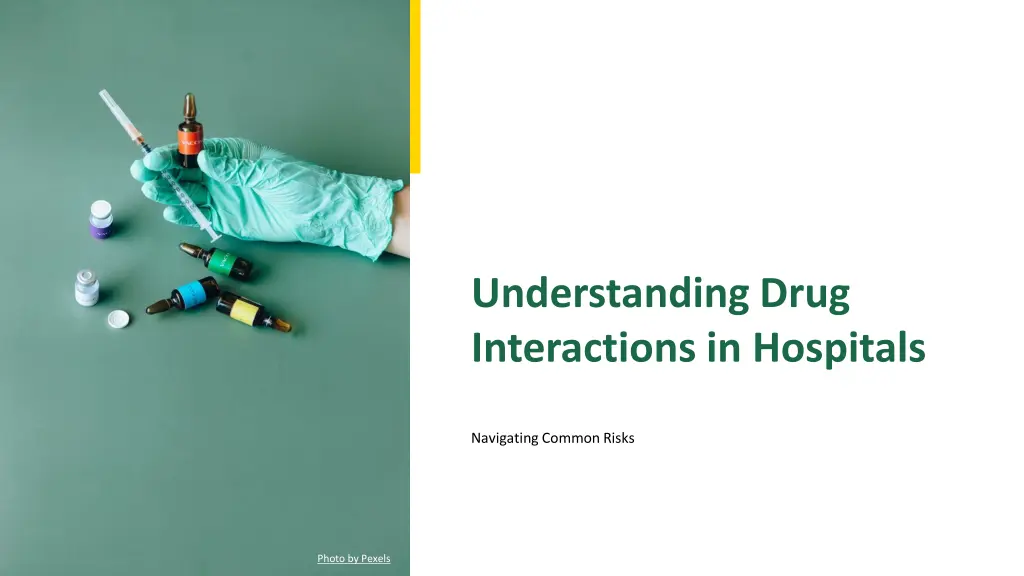
Understanding Drug Interactions in Hospitals: Navigating Risks
Explore the impact of drug interactions on patient outcomes in hospitals. Learn about common interactions, such as spironolactone and furosemide, and the importance of monitoring and educational initiatives. Discover how correlations guide patient safety protocols. Engage in collaborative care and ensure regulatory compliance for a safer future in healthcare.
Download Presentation

Please find below an Image/Link to download the presentation.
The content on the website is provided AS IS for your information and personal use only. It may not be sold, licensed, or shared on other websites without obtaining consent from the author. If you encounter any issues during the download, it is possible that the publisher has removed the file from their server.
You are allowed to download the files provided on this website for personal or commercial use, subject to the condition that they are used lawfully. All files are the property of their respective owners.
The content on the website is provided AS IS for your information and personal use only. It may not be sold, licensed, or shared on other websites without obtaining consent from the author.
E N D
Presentation Transcript
Understanding Drug Interactions in Hospitals Navigating Common Risks Photo by Pexels
01 Introduction to Drug Interactions Table of Contents 02 Spironolactone and Furosemide 03 Importance of Monitoring 04 Correlations of Drug Interactions 05 Educational Initiatives 06 Technology in Pharmacy 07 Case Studies 08 Patient Education 09 Collaborative Care 10 Regulatory Guidelines 11 Future Directions 12 Conclusion
1 Introduction to Drug Interactions Key Overview Drug interactions can significantly affect patient outcomes and treatment efficacy in hospitals. Awareness and management of these interactions are crucial for patientsafety. This presentation explores common interactions found in hospital settings. Let s delve deeper into the most notable cases and statistics. Photo by Pexels
2 Spironolactone and Furosemide A Common Interaction The most frequently encountered drug interaction is between spironolactone and furosemide. Both medications are diuretics, often used for managing fluid retention. Their combined use can lead to severe hyperkalemia and other complications. Close monitoring is essential when these are prescribed together. Photo by Pexels
3 Importance of Monitoring Patient Safety First Monitoring patients for drug interactions is critical to avoid adverse effects. Hospital pharmacies play a vital role in identifying potential interactions. Regular reviews of patient medication lists can prevent complications. Engagement with healthcare providers enhances overall safety. Photo by Pexels
4 Correlations of Drug Interactions Understanding Patterns Significant correlations exist between certain drug combinations and adverse reactions. For instance, potassium-sparing diuretics with potassium supplements can be dangerous. Analyzing these patterns helps in predicting potential risks. Data-drivenstrategies can improve patient safety protocols. Photo by Pexels
5 Educational Initiatives Training Healthcare Professionals Education on drug interactions is essential for all healthcare personnel. Regular training sessions can improve awareness and knowledge. Pharmacists should lead discussion groups on recent findings. Empowered staff can better safeguard patients against interactions. Photo by Pexels
6 Technology in Pharmacy Leveraging Innovations Advanced software tools can aid in detecting drug interactions promptly. Automated alerts during prescription can minimize human errors. Integration of technology into pharmacy practices is beneficial. It helps create a safer hospital environmentfor patients. Photo by Pexels
7 Case Studies Real-Life Examples Reviewing case studies provides insights into handling drug interactions effectively. Many hospitals have documented instances of interactions improving practices. Learning from past experiences is key to progress. Utilizing case studies in training can enhance understanding. Photo by Pexels
8 Patient Education Involvement of Patients Educating patients about their medications is crucial for safe use. Patients should be aware of potential interactions and side effects. Providing informational resources can empower them further. Encouraging questions fosters a collaborative treatment approach. Photo by Pexels
9 Collaborative Care Team Approach Collaboration between pharmacists, doctors, and nurses is essential. Strengthening teamwork leads to better detection of interactions. Regular interdisciplinary meetings can enhance communication. A unified approach elevates patient care standards. Photo by Pexels
10 Regulatory Guidelines Staying Compliant Understanding and implementing regulatory guidelines is vital. Hospitals must adhere to policies regarding medication management. Following these guidelines helps protect patients from harm. Compliance should be regularly reviewed and updated. Photo by Pexels
11 Future Directions Looking Ahead The future of drug interaction management is promising with ongoing research. Emphasizing personalized medicine can reduce risks significantly. Developing new protocols and technology will pave the way forward. Continuous improvement in practices is essential. Photo by Pexels
12 Conclusion Thank You! In conclusion, understanding drug interactions is paramount in hospital settings. By implementing effective strategies, we can enhance patient safety. Let s work together to minimize risks and optimize care. Thank you for your attention and participation! Photo by Pexels
